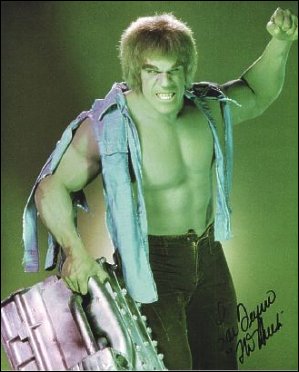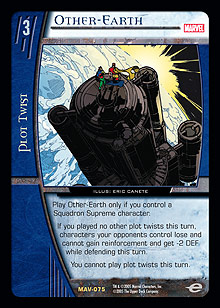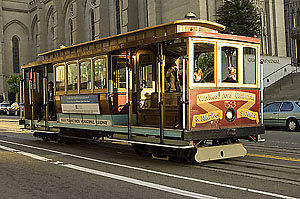
We are now several weeks removed from Pro Circuit San Francisco and many players are firmly in Pro Circuit Indy mode. This means for most professional players (and those who aspire to make it to that level) that Justice League of America and Infinite Crisis are the only sets that matter. So, appropriately, this article will be covering the topic that will be in the forefront of many players’ minds as they contemplate what decks to build, test, and take to PC Indy. That topic is, of course, our namesake: the metagame.
When I sat down to write this article, I had several topics in mind that I would have liked to share. It was only after talking to a good friend of mine, Jason Hager, that I finally decided on a direction to go. Specifically, we were discussing, in generalities, what we expected to see at the next Pro Circuit. It occurred to Jason that I should write an article about that very topic. I immediately fell in love with the idea. My previous articles dealt with what your opponent is playing and/or the goals of your own deck, which both tie in nicely with predicting the field at an event accurately. What follows will be an attempt to show you what was predicted at Pro Circuit San Francisco, what was present when the event was said and done, and what is predicted to show up at Pro Circuit Indy.
Lou Who?
As many of you may know, I am heavily engaged in wedding preparations. As I write this, my fiance is giving me dirty looks and addressing invitations. I digress. What is truly important about this is the heartfelt congratulations and love expressed by friends and family. I had received just about every note, letter, email, text message, and phone call that I expected to receive. All our relatives were off the list, as well as all of our friends. So, last week, when my phone rang with an unknown number, I was hesitant to pick up.
 I picked up the phone, and a thick New York accent asks for Shane. “This is Lou Ferrigno . . . from Hollywood.” I sat there for a second and thought to myself, “This can’t be real.” My initial impression was that it had to be one of those soundboards where you can make prank calls with celebrities. I instantly asked him who he was looking for again. Again he said, “Shane.” Then he told me, “I just wanted to tell you congratulations on your engagement and upcoming wedding.” I was in complete and utter shock. Was this really the former Mr. Universe and, more importantly, the Incredible Hulk? Was I dreaming? Was this some sort of cruel prank? I meekly uttered, “Thank you.” He then said that he was in Hollywood (he must have wanted me to believe he was still a high roller) and that he needed to go. I sat there in disbelief.
I picked up the phone, and a thick New York accent asks for Shane. “This is Lou Ferrigno . . . from Hollywood.” I sat there for a second and thought to myself, “This can’t be real.” My initial impression was that it had to be one of those soundboards where you can make prank calls with celebrities. I instantly asked him who he was looking for again. Again he said, “Shane.” Then he told me, “I just wanted to tell you congratulations on your engagement and upcoming wedding.” I was in complete and utter shock. Was this really the former Mr. Universe and, more importantly, the Incredible Hulk? Was I dreaming? Was this some sort of cruel prank? I meekly uttered, “Thank you.” He then said that he was in Hollywood (he must have wanted me to believe he was still a high roller) and that he needed to go. I sat there in disbelief.
About five minutes later, my good friend and teammate John Hall called me. I immediately drilled him, asking him if he had just prank called me. He said he didn’t and asked why I would ask that. I told him that Lou Ferrigno just called me. He started laughing hysterically and said that was why he called. As part of my wedding present, John Hall paid Lou Ferrigno to call me. Needless to say, it made my week, and I am still laughing about it now. After all, how often does the Incredible Hulk call and wish you luck in your marriage? This is definitely a good way to start. I just wish I knew it was coming so I could have said something along the lines of, “You wouldn’t like me when I’m angry!”
Look into the Crystal Ball!
What did that story have to do with what we are going to talk about today? Well, it’s simple really. I had expected all the other messages, but it was the phone call I didn’t expect that rocked my world and totally impressed me. This is no different than trying to predict the metagame at a premier-level event. Many times, what is expected to show up and what actually does appear are completely different.
The important question to answer then is, how can we predict what will show up? Primarily, it’s done by testing and refining deck ideas, but there are always those few stalwarts that make it through the cracks. Having those concepts in your playtesting gauntlet can be invaluable when tournament time comes around. What follows is a timeline, detailing three very specific moments, which I hope will aid you in determining what to playtest against.
Pre–Pro Circuit Atlanta
This was the first Marvel Modern Age where certain Golden Age decks could easily make the transition. Michael Jacob had proven that Avengers reservist was a force to be reckoned with in a $10K format. TAWC’s own John Tatta piloted Squadron Supreme to a 10th place finish at PC Los Angeles in November. Those two decks were the big favorites in Atlanta.
There was, of course, lots of talk about the new The X-Men set. The final consensus was that every team could make some sort of showing at the PC, and TAWC tried to show up with every deck build imaginable.
Post–Pro Circuit Atlanta
Squadron Supreme was everywhere. There was a reason it was picked, as it had incredible speed and consistency. The lack of Avengers reservist was surprising. No one knows why it did not show up in force, but I will venture a guess.
When a deck is expected to be a large part of the metagame for an extended period of time, it allows good deck builders to come up with strategies that counter it. Now, there weren’t any particularly good tech cards against Avengers, but knowing exactly how to play a matchup has its advantages, especially if your opponent doesn’t have the same knowledge of your deck. He or she is much more likely to make mistakes, and likewise, you are in much a better position to capitalize on them.
Those were two of the decks present, but what about everything else? Below is a metagame breakdown from Atlanta:
Squadron Supreme 122
Avengers reservist 52
Brotherhood reservist 37
X-Men(tal) 28
Morlock Beats 21
Faces of Evil 20
Hellfire Club 15
Brotherhood/Avengers reservist 14
Physical Beats 2
Masters of Evil/Morlocks 2
Mutant Energy 2
Mutopia 2
Blackbird Blue Beats 2
Burn 1
Kang 1
Kang/Hellfire 1
Faces of Evil/Brotherhood 1
Multiple Man Special 1
As you can see, this wasn’t exactly what everyone was predicting. The field was very diverse.
 Why did Squad do so well? The Squadron build that won was a toolbox deck. It tried to beat you into submission by limiting your options and maximizing its own. The deck that my teammates and I used was a straight Squad build that maximized the use of Other-Earth to win on turn 5. That card single-handedly is the reason that Squadron Supreme is so powerful. Granted, they also have cards like Panacea Potion and Answer the Call that allow you to abuse the empty hand strategy, but Other-Earth put them over the top.
Why did Squad do so well? The Squadron build that won was a toolbox deck. It tried to beat you into submission by limiting your options and maximizing its own. The deck that my teammates and I used was a straight Squad build that maximized the use of Other-Earth to win on turn 5. That card single-handedly is the reason that Squadron Supreme is so powerful. Granted, they also have cards like Panacea Potion and Answer the Call that allow you to abuse the empty hand strategy, but Other-Earth put them over the top.
Of the small portion who played Faces of Evil (20), two of them made Day 3. Also, there were two X-Men(tal) players who also made Day 3 out of a pool of 28 players.
What do these numbers suggest? First, that practicing against established decks is a good thing (with over a third of the field taking Squadron Supreme), and second, that paying attention to new ideas is important, as new decks made up half of the Day 3 competition.
Pre–Pro Circuit San Francisco
Much like Pro Circuit Atlanta, there were some clear-cut favorites right out of the gate. The Anti-Green Lantern deck had been making waves for weeks on the $10K circuit. The big question was, in a format where Dr. Doom, Diabolic Genius and his Reign of Terror would not be present, could those AGLs usurp his throne? It was no secret that Rian Fike felt that they could and should.
Along with AGL, G’Lock was expected to make an appearance. I have spoken about this deck in my earlier article that dealt with testing, which can be found here. I won’t speak about its dominance or ease of play, but I will say it was largely expected to make a big appearance.
Another deck that was expected to make a large showing was “Good Guys,” an ally-based deck consisting of JLA/JLI characters. This deck had been doing remarkably well in tournaments and was fresh enough to make individuals feel that it could take opponents by surprise.
Much like the previous Pro Circuit, San Francisco had a set release less than a full month before. This made it extremely difficult to predict what you might see or play against at the event. The Fate Artifacts obviously were a concern, but other than that, the community was quiet. It was not clear if the lack of talk was a result of not knowing or not wanting to share. However, this silence was broken the week before the Pro Circuit, when Ivy League burst onto the scene.
Post–Pro Circuit San Francisco
Here is what the metagame breakdown looked like for Pro Circuit San Francisco:
“Killing Joke” – Justice League of Arkham - 41
Squadron variants - 35
“Good Guys” – JLA / JLI ally - 25
Checkmate Toolbox (inc. “Chess”) - 21
G’Lock - 15
Fate-a-Tron (decks that involve getting all the Artifacts) - 9
Anti-Green Lantern - 8
Shadow Creatures (“Gremlins”) - 8
Faces of Evil (inc. X-Faces variants) - 8
Avengers reservist – 7
Burn (High Voltage Style) - 6
Brotherhood reservist - 5
Injustice Gang Hand-Flood - 5
Midnight Sons control - 5
Marvel Knights concealed - 4
Justice League Task Force - 4
Underworld / Secret Society (KO’d pile manipulation) - 4
Villains United Toolbox - 3
Shadowpact - 2
JSA / Checkmate - 2
X-Men(tal) - 2
Secret Society leader - 2
Morlocks / Parademon combo - 2
Other decks (including GLEE, Manhunter hidden, Spider-Friends, Injustice Gang / Villains, JSA, Villains / Revenge Squad, Villains control, Checkmate / Syndicate, Secret Society, Villains United, unaffiliated, Concealed beats, Injustice Gang Army, Hellfire / Marvel Knights, X-Men beats, Avengers / X-Men Team Attack, X-Energy) - 38
 As you can see, Ivy League in some form or another was the most-played deck in the format, which was a complete shock to me. My team didn’t tech any of those cool cards like Sage, Xavier’s Secret Weapon to deal with the deck. Obviously, we should have.
As you can see, Ivy League in some form or another was the most-played deck in the format, which was a complete shock to me. My team didn’t tech any of those cool cards like Sage, Xavier’s Secret Weapon to deal with the deck. Obviously, we should have.
However, Good Guys and G’Lock also made decent showings, taking 3rd and 5th most-played decks, respectively. This PC was the most diverse I had ever seen, but the cream rose to the top. Checkmate was a force to be reckoned with, as well as Ivy League, and, for the third straight PC, Squadron Supreme. I know FTN shudders when its deck is referred to as a Squadron build, and I mean no disrespect, but when Golden Archer shows up and wrecks havoc like he has in three straight PCs, it’s worth noting.
Pop Quiz Time!
So, what did we learn from this rather lengthy history lesson?
- The predicted metagame is not always correct. As we saw at Pro Circuit San Francisco, only Good Guys and G’Lock showed up the way people thought they would, but they were in fewer numbers than other, unknown decks.
- Even when the predicted metagame is accurate, it doesn’t necessarily mean that those decks are the best in the format. We can look to Pro Circuit Atlanta as well as San Francisco for examples of this.
- Predicting what is going to be played requires a lot of time and energy. One of the reasons that Avengers, Squadron, Good Guys, G’Lock, and AGL were predicted was that they were already made and people knew about them. Never underestimate the power of an individual’s ability to create something new. Only by trying this yourself will you come across truly unique ideas.
Pre–Pro Circuit Indianapolis
You have already seen, for the most part, what I expect the metagame to be in my previous article about testing. I will briefly reiterate for you here:
- Good Guys: It was the #3 played deck at Pro Circuit San Francisco and I don’t see why it won’t continue that trend upward. It loses very little in the transition from Silver to Modern Age. Expect this deck to come in with both High-Tech Flare Guns blazing. Yes, that was a little bit of tech. I know. Don’t hyperventilate. A writer actually revealed something.
- Fate-a-Tron: Another deck that doesn’t lose the key cards that make it work. If anything, I envision this deck being played in the same numbers as Atlanta’s Squadron Supreme. It has a powerful card that can win you the game, Fate Has Spoken, and it can be very consistent with cards like Dr. Fate’s Tower and Jaime Reyes ◊ Blue Beetle searching out your pieces.
- Checkmate Variants: Ahmed Samsarra is one crazy dude. He is single-handedly responsible for ushering in the era of locations. It’s been a while since locations have figured prominently in a metagame, and I am glad to see them back. The ability to search for tech locations as well as for your win conditions can’t be understated.
Let me say this about the above list: I am not trying to hide the ball. This is where I honestly expect the metagame to be. So what does that mean? At this point, I am missing several decks that will show up. It’s entirely possible that the best deck in the format has not even been thought up yet, but I am sure Jason Hager is hard at work on it as we speak.
In the End
In the end, remember those three points I illustrated to you earlier when contemplating the metagame. Keeping those thoughts in mind will challenge you to think outside the box—a route many players take to success in this game. Thank you for taking the time to read this article, and I look forward to hearing from many of you as we work to explore this new metagame!